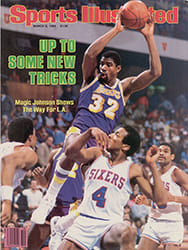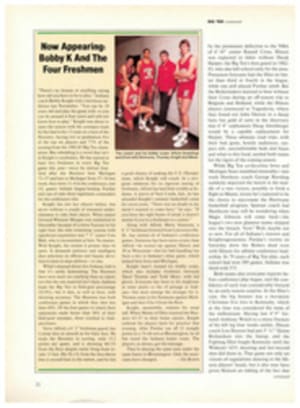
They kept the joint jumping
As a child growing up in southern Russia she dreamed of becoming a ballerina, but then she continued growing, to 5'10" and 135 pounds, and had to settle for being the world's best woman high jumper. "She is a princess," said one of her Soviet teammates at last Friday night's USA/Mobil Indoor Track & Field Championships in New York. And indeed, as the bar moved up in the women's high jump competition, Tamara Bykova, she of the fluffy blonde hair, sparkling brown eyes and expressive smile, was captivating the 15,925 fans in Madison Square Garden. "I think she is a classic beauty," said Soviet national coach Igor Ter-Ovanesyan. "Besides that, she can jump."
Bykova, 25, the women's world champion and indoor and outdoor world record holder, had already jumped 6'3½" to win the event. Now she had the bar raised to 6'5" in an attempt to equal the U.S. indoor all-comers record held by Debbie Brill of Canada. "Coaches tell me I have ability to make 2.10 meters [6'10¾"]," says Bykova, whose outdoor world record is 6'8¼". "Me, I do not know."
Bykova did not take up high jumping until age 16, and her years of ballet study grace her jumping style. She bounded in and cleared 6'5" easily on her first try. "Tonight she wants very much the world record," said Soviet journalist-team interpreter Vladimir Gheskin. But Bykova's year-old indoor mark is a tough 6'8", and it must be approached gradually. Bykova struck her favorite casual pose—shoulders slouched, one leg in front of the other, hands facing forward on hips—and had the bar placed at 6'6¾".
All week long she had enjoyed New York's sights, shows and media spotlight; Bykova carries herself like an actress and seems extremely Westernized. "Americans, they know the best ways to enjoy themselves," she says. Though she is from a family of modest means in Azov, a city of 59,000 on the Don River, her father a road engineer and her mother a restaurant worker, Bykova is now famous throughout her homeland. Her victory at last summer's World Championships in Helsinki—by far her biggest, on a jump of 6'7"—assured that. She studies journalism at Rostov State University, less than 25 miles from her hometown, and her goal is an on-camera TV career. She is reticent only, it seems, when speaking English, although she knows it fairly well. Of Friday's meet she would offer but two words: "Very wonderful."
With the bar at 6'6¾", Bykova straightened up, shook the tightness from her arms, took her usual series of funny little hop steps forward and back, and was off. She charged forward with startlingly long gazelle strides, driving her arms as high as would a Nordic skier. "She jumps very much with her arms," says Ter-Ovanesyan. At takeoff Bykova hurled herself upward into a smooth trajectory. She arced softly over onto the pad and watched the bar's barely detectable quiver. Brill's record was gone.
Three close misses at 6'7½" neither dampened Bykova's spirits nor kept her from winning a silver bowl as the meet's outstanding woman performer. The failures did, however, shift attention to another set of jumping standards across the infield.
"Always the last competition is the high jump, no?" said Ter-Ovanesyan, the former long jump world record holder (27'3¼", 1962-64; 27'4¾", '67-68), as he watched the men's bar rise to 7'7" and the clock close in on Saturday. These U.S. nationals, the first attended by U.S.S.R. athletes since 1975, had proved to be a successful finale for the Soviets' exhausting 16-day, five-meet North American tour. Bykova had jumped spectacularly, world indoor record holder Sergei Bubka had won the pole vault with a jump of 18'6" and Lyubov Gurina had won the women's 880 in 2:05.34. Still competing in the high jump—and looking strong—was Igor Paklin, who until several hours earlier had been the world indoor record holder in the event. At a meet in Berlin earlier on Friday, West Germany's Carlo Thranhardt had cleared 7'9¼" to break Paklin's three-week-old mark of 7'8¾".
Paklin, a 6'3" 20-year-old, had hoped to meet world outdoor record holder (7'9¾") Zhu Jianhua of the People's Republic of China in the Garden. But despite a publicity buildup, despite New York's clamor for a nice Zhuish boy who can high jump, Jianhua scratched, citing a viral illness. "He has, I think, a diplomatic illness," said Gheskin, noting the strong field of jumpers.
With a 7'5¾" clearance, Paklin, who has been nicknamed Pac-Man by the American jumpers, had eaten up all but two of his rivals, including his world champion teammate, Gennadiy Avdeyenko, who'd placed sixth at 7'2½", and Dwight Stones, fourth at 7'4¼". Left were former Texas A&M jumper Jim Howard and an unknown quantity named Dennis Lewis. "Is new face, huh?" said Ter-Ovanesyan.
The 24-year-old, 6'4", 185-pound Lewis, for whom high jumping is little more than a hobby, breezed over 7'7" on his first attempt. He has actually been around for a while, having attended Michigan State in 1977-78, during which time he placed second at the NCAA indoor championships with a jump of 7'3". But he has never trained enough. He took a job at a Ford plant in Ypsilanti after leaving Michigan State, and now works the 11 p.m. to 7 a.m. graveyard shift at a plastics company in Ypsilanti. He jumped in only three local meets in 1983 before succumbing to pericarditis, an inflammation of the heart sac, from which he has since recovered. But even now, though he works out regularly at Eastern Michigan University, he polishes his jumping technique only during meets. He came into Friday's meet with a PR of 75¼".
After Lewis' 7'7" leap, Paklin and Howard, who has jumped 7'6½", both missed their first attempts at 7'7". They passed their remaining tries and, looking to win, had the bar raised to 7'8", one-quarter inch above Jeff Woodard's American indoor record. Lewis took the first crack at it and missed by the thickness of his gray singlet.
Paklin, up next, stormed full-out toward the standards. Just as he began his sharp curve to the bar, however, he slipped on a cable leading from a TV camera. Paklin skidded and fell, slamming down hard on his right side in a patch of dirt that had been tracked over from the long jump pit. It was perhaps the nastiest indoor fall ever on U.S. soil.
Workers pushed back the cable and swept off the dirt, but clearly the Soviet juniper was shaken. He took his jump over and missed. Howard then failed. On their final tries all three dislodged the bar, though Paklin's effort was impressive: Had he not kicked the bar with his heels, he could have cleared 7'9".
"I think I can break the world record by the time the Olympics roll around," Lewis was saying to a cluster of reporters, virtually the only people left in the Garden at 12:15 a.m. "He could do it, too," said former Olympic high jump bronze and silver medalist John Thomas, who was on hand as marshal for the women's high jump competition. That is, if Lewis' anonymity doesn't do him in first. A few days earlier, TAC officials had nearly dropped him from the meet because they couldn't find his entry blank. "The national champion," said Kevin Ryan, manager of the New Balance Track Club, which now numbers Lewis among its members, shaking his head, "and they were going to turn his entry down."
Some things at U.S. track nationals just can't be explained, and the Soviets, too, were finding that out. When Howard and Paklin tied for second place, officials told Paklin that because they had only one silver medal left, they would flip a coin to see who would get it. Haifa dozen members of the Soviet delegation were speechless in disbelief. Paklin wasn't. "Chisto po Amerikansky," he groused. Rough translation: "So that's the American way."
Paklin was then shown a quarter. ("This is heads, this is tails.") He was beside himself. "Tails," he finally said.
"Aha, heads," grinned a tuxedoed judge, shoving the bronze at Paklin. Paklin looked at the medal as if it were a handbill advertising a 42nd Street massage parlor and stalked off, weeks of American goodwill destroyed.
But at least Bykova was pleased with her visit to the U.S. Not only had she won both meets in which she had jumped, but also while examining Olympic preparations at the Los Angeles Coliseum, she had come upon a felicitous omen. Lying on the high jump apron was a gold chain. She picked it up and took it home.
"It may be my talisman," said Bykova, in perfect English.
"So even now she has gold from Los Angeles Coliseum," said Gheskin.
TWO PHOTOS
Bykova took the U.S. all-comers record and Los Angeles gold back home to Azov.
TWO PHOTOS
The unheralded Lewis took time out from the night shift and punched in at 7'7".

